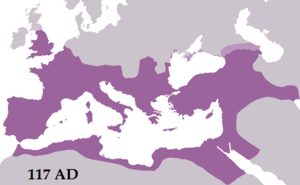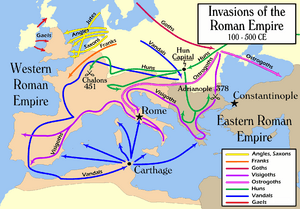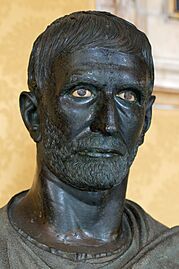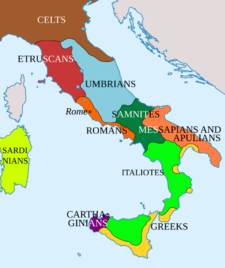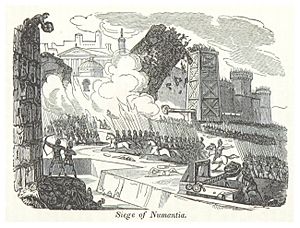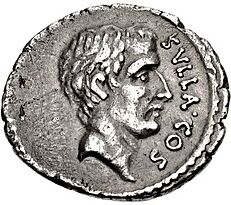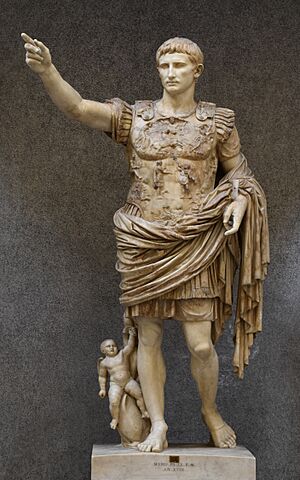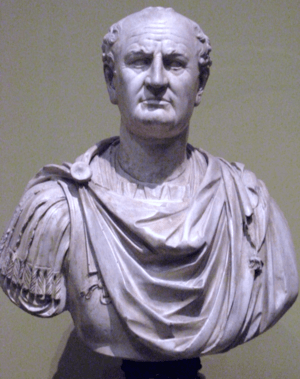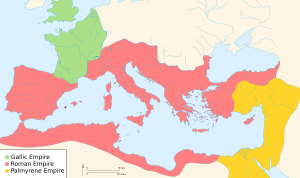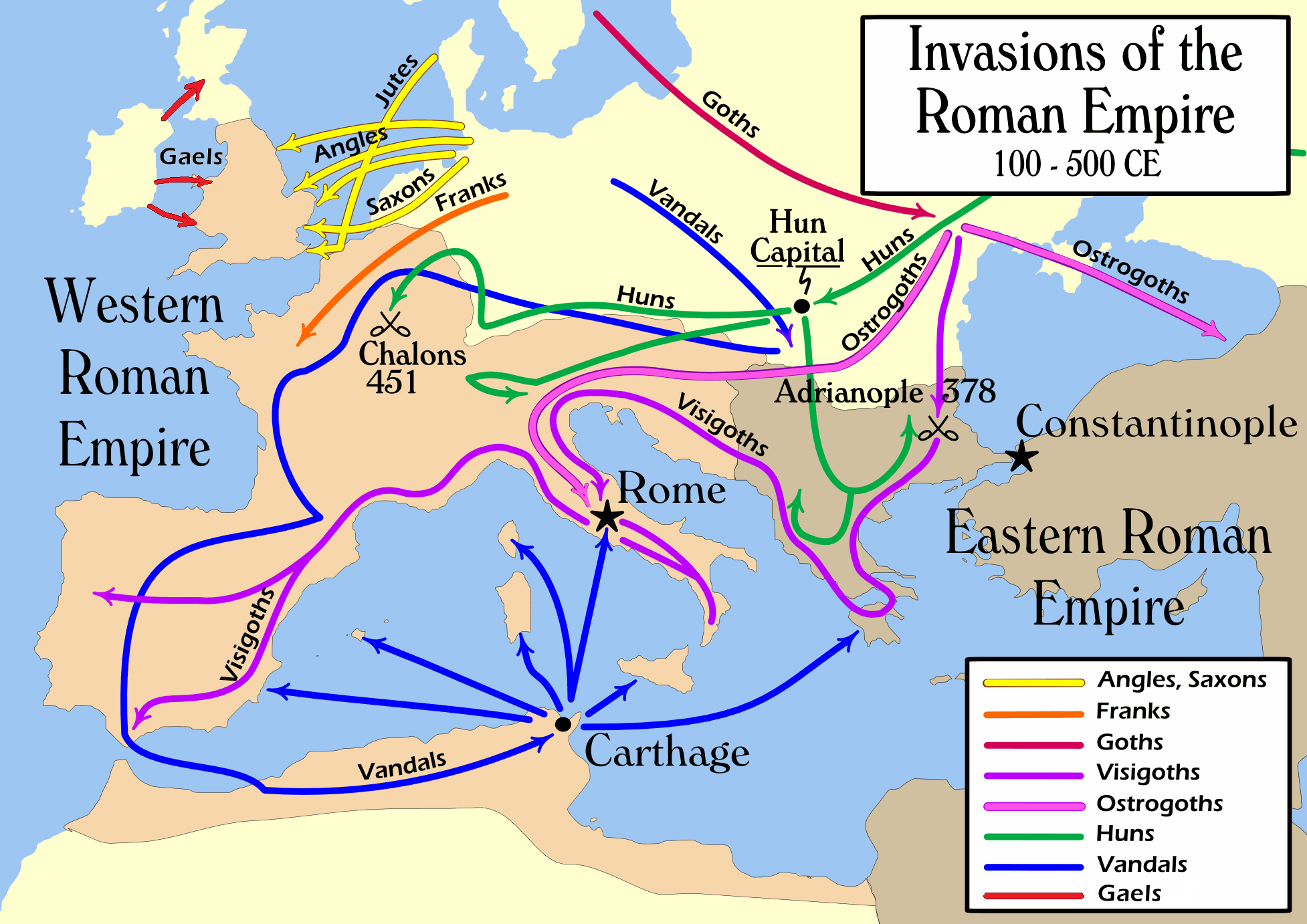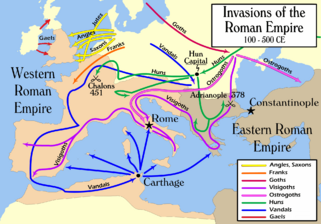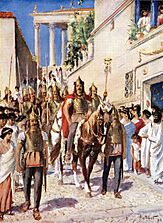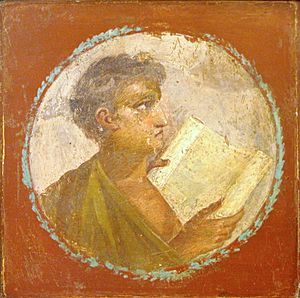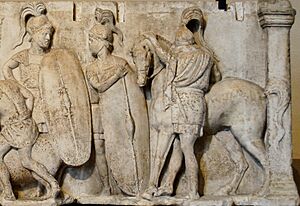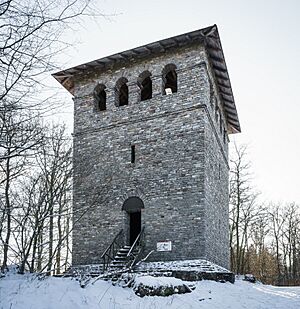Ancient Rome facts for kids
Ancient Rome was a powerful civilization that started in Italy. It began as a small farming village around the 8th century BC. This village grew into a city called Roma, named after its legendary founder, Romulus. Over time, it became the largest empire in the ancient world.
Rome's government changed over the years. It started as a kingdom, then became a republic, and finally, a huge empire.
The Roman Empire became so vast that it was hard to rule. Its lands stretched from Britain all the way to the Middle East. In 293 AD, Emperor Diocletian decided to split the empire into two parts. Later, in 395 AD, it was permanently divided into the Western Roman Empire and the Eastern Roman Empire.
The Western Empire fell apart in 476 AD, mainly due to invasions from Germanic tribes like the Visigoths. The western part then broke into many smaller kingdoms. However, the Eastern Roman Empire, also known as the Byzantine Empire, continued to thrive. It lasted for nearly a thousand more years until it was defeated by the Ottoman Empire in 1453.
Rome was founded, according to stories, on April 21, 753 BC. It fell in 476 AD. This means it was independent for almost 1200 years and was a major world power for about 700 years. This long history makes it one of the longest-lasting civilizations of antiquity.
Contents
- How Did Ancient Rome Begin?
- Roman Society
- Roman Culture
- Roman Food
- Roman Fashion
- Roman Technology
- Archaeology
- Images for kids
- See also
How Did Ancient Rome Begin?
Early Settlements and Rome's Founding
We have found signs of people living around Rome from about 1000 BC. More organized communities appeared around 800 BC. This is when the first graves were made on the Esquiline Hill. A clay and wood wall was also built at the bottom of the Palatine Hill around the mid-8th century BC.
Around 650 BC, Romans started draining the valley between the Capitoline and Palatine Hills. This area later became the famous Roman Forum. By the 6th century BC, Romans were building the Temple of Jupiter Optimus Maximus on the Capitoline Hill. They also expanded towards the Forum Boarium, which was between the Capitoline and Aventine Hills.

The Roman Kingdom
Ancient Roman texts from the 6th century BC show that Rome definitely had kings. The Romans believed their kings were chosen by the people, not born into the role. There were seven legendary kings, and they were mostly not related to each other.
Rome started to grow bigger in the 6th century BC. By the end of this century, Rome controlled an area of about 780 square kilometers (300 square miles). Its population might have been as high as 35,000 people. The Romans also began to control their Latin neighbors. These Latin cities shared a common culture, with similar rights for marriage and citizenship. They also had shared religious festivals. By the end of the 6th century, Rome was the most powerful city in this area.
The Roman Republic
Around the end of the 6th century, Rome and its neighbors faced a lot of trouble, including wars. According to tradition, the Roman Republic was formed around 509 BC. This happened when the last king, Tarquin the Proud, was removed from power.
The new system had leaders called magistrates who were elected every year. There were also different groups of people who could vote. The most important leaders were the two consuls. They were in charge of the government and the army. The consuls had to work with the Senate. The Senate was a group of important noble families, called patricians. Over time, the Senate grew in size and power.
Other important leaders in the Republic included tribunes, quaestors, aediles, praetors, and censors. At first, only patricians could hold these jobs. But later, common people, called plebeians, were also allowed to become magistrates.
In the 4th century BC, the Gauls attacked Rome. A Gallic army led by Brennus defeated the Romans in 390 BC. The Gauls then looted and burned the city. They even surrounded the Capitoline Hill for seven months. The Romans eventually paid the Gauls a large amount of gold to leave. Legend says that a Roman general named Camillus later declared, "With iron, not with gold, Rome buys her freedom!"
The Romans slowly took control of other groups in Italy, including the Etruscans. They secured their new lands by building Roman colonies in important areas. This helped them keep strong control over the region.
The Punic Wars: Rome vs. Carthage
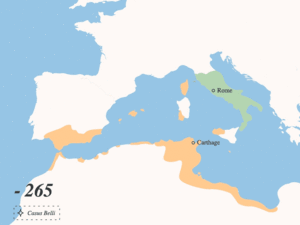
In the 3rd century BC, Rome faced a powerful enemy: Carthage. Carthage was another major power in the Western Mediterranean Sea. The First Punic War started in 264 BC. Rome got involved because Carthage was getting too close to newly conquered Roman lands in Southern Italy. Rome also wanted to control Sicily.
Carthage had a strong navy, and Rome was not used to fighting at sea. So, winning the war was long and hard for Rome. But after more than 20 years, Rome defeated Carthage and signed a peace treaty.
The Second Punic War began because Carthage was unhappy about the peace terms from the first war. This war started with Hannibal of Carthage bravely invading Hispania and marching over the Italian Alps. He caused great fear among Rome's allies in Italy. Rome's best plan was to use guerrilla warfare, avoiding big battles, to wear down Hannibal. Hannibal's invasion lasted over 16 years, causing much damage in Italy. But Rome finally defeated Carthage in the important Battle of Zama in 202 BC.
More than 50 years later, Carthage had recovered some of its power. The Roman Senate decided that Carthage was still a threat. The Third Punic War began in 149 BC. Carthage fought hard at first, but it could not stop Scipio Aemilianus. He completely destroyed the city, enslaved its people, and Rome gained control of the region, calling it the province of Africa. These wars helped Rome become a major imperial power, gaining its first lands outside Italy like Sicily, Hispania, and Africa.
Challenges in the Late Republic
After defeating the Macedonian and Seleucid Empires in the 2nd century BC, the Romans became the most powerful group in the Mediterranean Sea. Rome was now a strong empire in terms of its military, with no major enemies.
But being powerful abroad led to problems at home. Senators became rich from the provinces. Soldiers, who were often small farmers, were away from home for too long and couldn't take care of their land. More slaves were used, which meant less paid work for free Romans. New wealth from wars and trade created a new class of rich merchants called equestrians.
The Senate often argued and stopped important land reforms. They also refused to give the equestrian class more say in government. Violent groups, controlled by rival Senators, used force to influence elections.
Things got worse in the late 2nd century BC with the Gracchi brothers. They were leaders who tried to pass laws to share large noble landholdings with common people. Both brothers were killed, and the Senate reversed their changes. This led to a bigger split between groups of plebeians (populares) and equestrians (optimates).
Gaius Marius became a powerful leader, serving as consul seven times. He changed the army by allowing very poor, landless men to join. This made the army larger and more loyal to its generals. After Marius retired, Rome had a brief peace. But then, Rome's Italian allies, called socii, demanded Roman citizenship. When their request was denied, they revolted in the Social War.
By the end of the Social War, Marius and Lucius Cornelius Sulla were the top military leaders. Their supporters fought for power. In 88 BC, Sulla marched his army into Rome, which was against the law. He killed those who supported Marius. Marius later returned to Rome and took power, also leading to harsh actions against his opponents.
Marius died in 86 BC. Sulla returned from his campaigns and marched on Rome a second time in 83 BC. He became a dictator and carried out a period of terror, executing thousands of nobles and senators. Sulla's actions greatly weakened the Roman Republic.
Caesar and the First Triumvirate
In the mid-1st century BC, Roman politics were very unstable. Political groups were split between the populares (who sought support from the common people) and the optimates (who wanted to keep power with the noble families).
Gaius Julius Caesar brought together the two most powerful men in Rome: Marcus Licinius Crassus and Gnaeus Pompeius Magnus (Pompey). Caesar married his daughter to Pompey. Together, they formed a secret alliance called the First Triumvirate (meaning "three men").
But this alliance didn't last. Caesar's daughter died in 54 BC. In 53 BC, Crassus was killed in a war. The Triumvirate fell apart. Caesar then conquered Gaul, gaining huge wealth and the loyalty of his experienced armies. He became a great threat to Pompey and was disliked by many optimates.
To stop Caesar, Pompey's group tried to take away his armies. To avoid this, Caesar crossed the Rubicon River and invaded Rome in 49 BC. Caesar won many battles, defeating all of the optimates leaders. Pompey was killed in Egypt in 48 BC. Caesar was now the most powerful man in Rome. He held many consulships and was made dictator for life. But he was murdered in 44 BC by a group of senators called the Liberatores.
Octavian and the Second Triumvirate
Caesar's death caused great chaos in Rome. His friend, Marcus Antonius, took control. Soon after, Octavius, Caesar's adopted son, arrived in Rome. Octavian joined forces with Antony and Marcus Aemilius Lepidus, Caesar's close friend. In 43 BC, they officially formed the Second Triumvirate. They punished many senators and knights who had supported Caesar's killers.
In 42 BC, the Senate declared Caesar a god. This made Octavian the "son of the deified." In the same year, Octavian and Antony defeated Caesar's assassins, Marcus Junius Brutus and Gaius Cassius Longinus, in the Battle of Philippi. The Second Triumvirate was known for its harsh punishments of many senators and knights.
The Triumvirate divided the Empire among themselves. Lepidus got Africa, Antony got the eastern provinces, and Octavian stayed in Italia and controlled Hispania and Gaul. The Triumvirate ended in 38 BC, but was renewed for five more years. However, Octavian and Antony's relationship worsened. Lepidus was forced to retire in 36 BC.
Antony was living in Ptolemaic Egypt with Cleopatra VII, its queen. Romans saw Antony's close relationship with Cleopatra as a betrayal. He also adopted a lifestyle that Romans thought was too extravagant. When Antony gave Cleopatra and their children royal titles to newly conquered eastern lands, war broke out between Octavian and Antony. Octavian destroyed Egyptian forces in the Battle of Actium in 31 BC. Antony and Cleopatra took their own lives. Egypt was then conquered by the Roman Empire.
The Roman Empire: The Principate
In 27 BC, at age 36, Octavian was the only leader in Rome. He took the name Augustus. Historians usually mark this as the start of the Roman Empire. Officially, the government was still a republic, but Augustus held all the real power. His changes to the government led to a 200-year period of peace, known as the Pax Romana.
The Julio-Claudian Family
The Julio-Claudian dynasty was started by Augustus. The emperors from this family were Augustus, Tiberius, Caligula, Claudius, and Nero. These emperors began to move away from republican ideas. But they also made Rome the most important power in the Mediterranean. While Caligula and Nero are often remembered as difficult emperors, Augustus and Claudius were successful leaders. This family set up the tradition of emperors ruling Rome.
Augustus (ruled 27 BC to AD 14) gathered almost all the republican powers under his title, princeps (first citizen). He reduced the political power of the senators and increased the power of the equestrian class. Senators lost the right to rule certain provinces, like Egypt, which were now directly controlled by the emperor. He also created the Praetorian Guard and reformed the military. He created a standing army of 28 legions, giving him full control over the military.
Compared to the time of the Second Triumvirate, Augustus's rule was very peaceful. This made the people and nobles of Rome support him. His generals, like Marcus Vipsanius Agrippa, Nero Claudius Drusus, and Germanicus, gained great respect. Augustus wanted to expand the Roman Empire. During his rule, Rome conquered lands like Cantabria, Aquitania, Raetia, Dalmatia, Illyricum, and Pannonia.
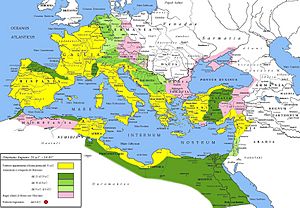
Under Augustus, Roman literature flourished in what is called the Golden Age of Latin Literature. Poets like Virgil and Horace wrote amazing works. Augustus supported patriotic poems, like Virgil's epic Aeneid. The month of August is named after him. Augustus brought a time of peace and prosperity to Rome, known as Pax Augusta or Pax Romana. He died in 14 AD, but the empire's greatness continued.
The Julio-Claudians continued to rule after Augustus's death until Nero died in 68 AD. Augustus chose his stepson, Tiberius, as his heir. The Senate agreed, giving Tiberius the same titles as Augustus. However, Tiberius was not very interested in politics. He retired to Capri in 26 AD, leaving Rome's control to his praetorian prefects.
Tiberius died in 37 AD. His grand-nephew Caligula became emperor. At first, he was popular, but he became a very harsh and unpredictable ruler. The Praetorian Guard murdered Caligula four years later. They then made his uncle Claudius the new emperor. Claudius was less strict than Tiberius and Caligula. He conquered Lycia and Thrace. His most important achievement was starting the conquest of Britannia. Claudius was poisoned by his wife, Agrippina the Younger, in 54 AD. Her son, Nero, became emperor.
Nero sent his general, Suetonius Paulinus, to invade modern-day Wales. The Celts there fought back strongly. In 60 AD, Paulinus attacked Mona (Anglesey), a sacred island for the druids. His soldiers massacred the druids and destroyed their shrines. While Paulinus was in Mona, tribes in modern-day East Anglia revolted. This revolt was led by Queen Boadicea of the Iceni. The rebels attacked and burned Camulodunum, Londinium, and Verulamium (modern-day Colchester, London, and St Albans). Paulinus eventually crushed the revolt. Boadicea took her own life to avoid being paraded in Rome.
Nero is known for being the first to persecute Christians. He is also rumored to have started the Great Fire of Rome. A plot against Nero failed in 65 AD. But in 68 AD, armies in Gaul and Spain revolted. The Praetorian Guards abandoned Nero, and the Senate condemned him to death. Nero then took his own life.
The Flavian Family
The Flavians were the second family to rule Rome. After Nero's death in 68 AD, there was no chance of the Roman Republic returning. A new emperor was needed. After a period of chaos, Titus Flavius Vespasianus took control and started a new dynasty. Under the Flavians, Rome continued to grow, and the empire remained strong. Under Trajan, the Roman Empire reached its largest size ever. Rome's control now covered about 5 million square kilometers (1.9 million square miles).
The most important military action during the Flavian period was the siege and destruction of Jerusalem in 70 AD by Titus. This happened after a Jewish uprising in 66 AD. The Second Temple was completely destroyed. Jerusalem was looted, and many people were killed or scattered.
Vespasian was a general under Claudius and Nero. He fought in the First Jewish-Roman War. After a year with four different emperors, Vespasian became emperor in 69 AD. He rebuilt many structures that were unfinished or destroyed by the Great Fire of Rome. Vespasian started building the Flavian Amphitheater, also known as the Colosseum. He sent armies to defend the eastern border and expanded Roman control in Britannia. He also reformed the tax system. Vespasian died in 79 AD.
Titus became emperor in 79 AD. He finished the Flavian Amphitheater, using treasures from the Jewish-Roman War. He held victory games that lasted for 100 days. These games included gladiatorial combats, horse races, and even a mock naval battle in the flooded Colosseum. Titus died in 81 AD and was followed by his brother Domitian. As emperor, Domitian acted like a tyrant. He ruled for 15 years and gained a reputation for acting like a living god. He was murdered after a plot within his own household.
The Nerva–Antonine Family
After Domitian's murder, the Senate quickly chose Nerva as emperor. Nerva was from a noble family and had advised Nero and the Flavians. His rule brought back many traditional freedoms for Rome's upper classes. The Nerva–Antonine dynasty (96 AD to 192 AD) included the "five good emperors": Nerva, Trajan, Hadrian, Antoninus Pius, and Marcus Aurelius. These emperors were known for their good rule. The Nerva-Antonine dynasty ended with Commodus, the son of Marcus Aurelius.
Nerva stepped down and died in 98 AD. He was followed by the general Trajan. Trajan is known for restoring rights to common people and senators. He fought three Dacian wars, gaining lands that are now part of modern-day Romania and Moldova. He also started many public building projects in Rome, including Trajan's Forum and Trajan's Column. He also improved the Pantheon and expanded the Circus Maximus. Trajan died in 117 AD.
Trajan's successor, Hadrian, pulled back all troops from Parthia, Armenia, and Mesopotamia (modern-day Iraq). He gave up Trajan's conquests. Hadrian's army crushed revolts in Mauretania and Judea. This was the last big Jewish revolt against the Romans. It was put down very harshly, with many people losing their lives. Hadrian renamed the province of Judea "Syria Palaestina". He built many fortifications and walls, like the famous Hadrian's Wall in Britain. Hadrian promoted culture, especially Greek culture. He also made laws more humane. He built many aqueducts, baths, libraries, and theaters. He traveled to almost every province to check on the military and buildings. Hadrian died in 138 AD.
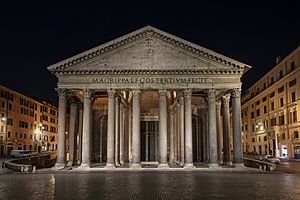
His successor, Antoninus Pius, built temples and promoted arts and sciences. He also continued Hadrian's policy of making laws more humane. Antoninus expanded Roman Britain by invading southern Scotland and building the Antonine Wall. He died in 161 AD.
Marcus Aurelius, known as the Philosopher, was the last of the Five Good Emperors. He was a stoic philosopher and wrote the Meditations. He defeated barbarian tribes and the Parthian Empire. His co-emperor, Lucius Verus, died in 169 AD, possibly from the Antonine Plague. This was a widespread sickness that killed many people across the Empire.
From Nerva to Marcus Aurelius, the empire reached a time of great success. Laws and customs brought the provinces together. People enjoyed their wealth. The idea of a free government was respected. Historians like Gibbon called the rule of these "Five Good Emperors" the golden age of the Empire. During this time, Rome was at its largest.
Commodus, Marcus Aurelius's son, became emperor after his father. He is not considered one of the Five Good Emperors because he was related to the previous emperor. Also, he was not very active militarily. Some historians say his rule marked the start of Rome's decline.
The Severan Family
Commodus was killed in a plot in late 192 AD. The next year was known as the Year of the Five Emperors. During this time, five different generals claimed to be emperor. Septimius Severus eventually took power. He and the emperors after him ruled with the support of the armies. Changes in money and military spending led to financial problems. These problems were part of the Crisis of the Third Century.
Severus became emperor after invading Rome and having Didius Julianus killed. Severus tried to bring back a very strong, centralized rule. He praised the harshness of earlier leaders like Marius and Sulla, which worried the senators. When Parthia invaded Roman land, Severus successfully fought against them. However, he failed to conquer the rich city of Hatra. After this difficult campaign, he pulled back his forces. Severus also wanted to conquer all of Britannia. He fought against the Caledonians. But he became ill and died in 211 AD.

After Severus died, his sons Caracalla and Geta became emperors. Caracalla had his younger brother killed. Like his father, Caracalla was a warlike emperor. He continued Severus's policies and gained respect from the armies. In 212, he issued the Edict of Caracalla. This law gave full Roman citizenship to almost all free men living in the Empire.
Macrinus arranged for Caracalla to be killed in 217 AD. Macrinus became emperor, but his rule was short. In 218, a young man named Bassianus, who was supposedly Caracalla's son, was declared emperor by soldiers. He took the name Antoninus, but history knows him as Elagabalus. He was not a good ruler and upset many people. Elagabalus adopted his cousin Severus Alexander. But then he became jealous and tried to kill him. However, the Praetorian Guard preferred Alexander and murdered Elagabalus. Severus Alexander then became emperor. Alexander fought many enemies, including a strong Persia and Germanic tribes. His losses made his soldiers unhappy, and some of them murdered him in 235 AD.
The Crisis of the Third Century
After the death of Alexander Severus, Rome faced a terrible time. The Roman state suffered from civil wars, outside invasions, political chaos, pandemics, and economic problems. Old Roman values declined. New religions like Mithraism and Christianity began to spread. Emperors were no longer from noble families. They were often born in distant parts of the Empire and rose through the military. They became emperors by winning civil wars.
There were 26 emperors in just 49 years, showing how unstable things were. Many ruled for only a few months. The population and the borders were neglected. Emperors were mostly focused on fighting rivals. The economy also suffered. Huge military spending caused Roman coins to lose value. Hyperinflation (prices rising very fast) also happened. The Plague of Cyprian broke out in 250 and killed a huge part of the population.
In 260 AD, some provinces in the East broke away to form the Palmyrene Empire, ruled by Queen Zenobia. In the same year, the Gallic Empire was created in the West, including Britain and Gaul. These areas broke away after Emperor Valerian was captured by the Sassanids of Persia. This was a very humiliating event for the Romans.
The crisis began to get better during the reigns of Claudius Gothicus (268–270), who defeated the Gothic invaders, and Aurelian (271–275), who brought back the Gallic and Palmyrene Empires. The crisis finally ended during the rule of Diocletian.
The Roman Empire: The Tetrarchy
Diocletian's Reforms
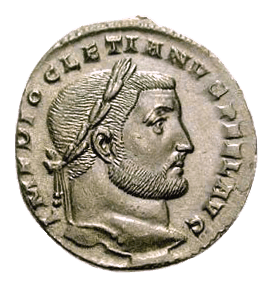
In 284 AD, Diocletian became emperor. He helped the empire recover from the crisis with new political and economic changes. He created a new form of government called the Tetrarchy. The Empire was divided among four emperors: two in the West and two in the East. The first four rulers were Diocletian (in the East), Maximian (in the West), and two junior emperors, Galerius (in the East) and Flavius Constantius (in the West). Diocletian also made tax reforms to fix the economy.
Diocletian fought against the Persians and conquered some barbarian tribes. He adopted many customs of Eastern kings. People now had to bow down before the emperor, which was new for Rome. Diocletian did not pretend that Rome was still a republic, as earlier emperors had done. Between 290 and 330, several new capitals were set up, including Milan and Trier. Diocletian also started a major persecution of Christians in 303. He ordered Christian churches and writings to be destroyed and forbade Christian worship. Diocletian was the first Roman emperor to resign. He stepped down in 305 AD. His rule ended the old way of imperial rule and started the Tetrarchy.
Constantine and Christianity
Constantine became emperor in 306. He fought many wars against the other emperors. First, he defeated Maxentius in 312. In 313, he issued the Edict of Milan. This law allowed Christians to practice their religion freely. Constantine himself converted to Christianity and promoted the Christian faith. He began the process of making the Empire and Europe Christian.
He was defeated by the Franks and the Alamanni between 306–308. In 324, he defeated another emperor, Licinius, and took control of the entire empire, just as it was before Diocletian split it. To celebrate his victories and the importance of Christianity, he rebuilt Byzantium. He renamed it Nova Roma ("New Rome"), but it soon became known as Constantinople ("City of Constantine").
Constantine's reforms reunited the Empire under one emperor. He rebuilt Byzantium as Constantinople, which became a new capital. Rome had lost its central importance since the Crisis of the Third Century. Constantine's changes marked a significant period in the ancient world.
The Fall of the Western Roman Empire
In the late 4th and 5th centuries, the Western Empire faced a very difficult time. This period ended with the fall of the Western Roman Empire. Under the last emperors, Rome lost important battles against the Sasanian Empire and Germanic barbarians. In 363, Emperor Julian the Apostate was killed fighting the Persians. The Battle of Adrianople cost the life of Emperor Valens (364–378). The victorious Goths were never removed from the Empire.
The situation became even worse in 408 after the death of Stilicho. He was a general who tried to reunite the Empire and push back barbarian invasions. The professional army collapsed. In 410, the Visigoths attacked and looted Rome.
During the 5th century, the Western Empire lost much of its land. The Vandals conquered North Africa. The Visigoths took the southern part of Gaul. Gallaecia was taken by the Suebi. Britannia was abandoned by the central government. The Empire also suffered from invasions by Attila, leader of the Huns.
General Orestes refused the demands of the barbarian "allies" who now made up the army. He tried to remove them from Italy. Unhappy with this, their leader Odoacer defeated and killed Orestes. He then invaded Ravenna and removed Romulus Augustus, Orestes' son, from power. This event in 476 usually marks the end of Classical antiquity and the start of the Middle Ages.
After 1200 years of being independent, Rome's rule in the West ended. Many reasons have been suggested for Rome's fall. These include problems with government, military issues, economic troubles, and diseases.
The Eastern Empire, also called the Byzantine Empire, lasted for almost 1000 years after the West fell. It became a very stable Christian kingdom during the Middle Ages. In the 6th century, Justinian reconquered Italy, North Africa, and southern Hispania. But soon after Justinian's death, the Lombards took much of Italy. In the east, the Byzantine Romans faced a new threat from the rise of Islam. Muslim armies quickly conquered lands in the Levant, Armenia, and Egypt. They soon threatened Constantinople itself.
However, the Byzantine Romans stopped further Islamic expansion in the 8th century. In the 9th century, they even took back some conquered lands. By 1000 AD, the Eastern Empire was at its peak. But this expansion stopped in 1071 with a major defeat at the Battle of Manzikert. This battle led to a long period of decline for the empire.
In 1095, Emperor Alexios I Komnenos asked Western European kingdoms for help. This led to the Crusades. In 1204, the Fourth Crusade attacked and looted Constantinople. This broke the empire into smaller states. The Eastern Roman (Byzantine) Empire finally fell when Mehmed the Conqueror conquered Constantinople on May 29, 1453.
Roman Society
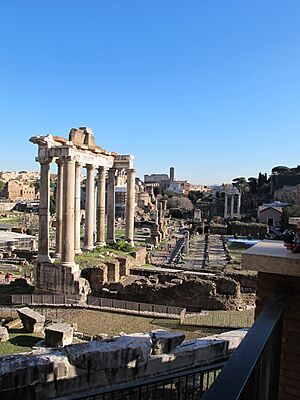
The city of Rome was the largest city in the empire. Its population was estimated to be between 450,000 and almost one million people. About 20% of the Roman Empire's population lived in cities. Many of these cities had a forum, temples, and other buildings similar to Rome's. The average life expectancy in the Middle Empire was about 26–28 years.
Roman Law
The laws of ancient Rome can be traced back to the Twelve Tables from 449 BC. They were also shaped by the laws ordered by Emperor Justinian I around 530 AD. Roman law continued to be used in the Byzantine Empire. It also formed the basis for many law systems in Western Europe. Roman law was used in most of Europe until the end of the 17th century.
Roman law had three main parts: Jus civile, Jus gentium, and Jus naturale.
- Jus civile ("Citizen Law") was for Roman citizens.
- Jus gentium ("Law of nations") was for foreigners and their dealings with Roman citizens.
- Jus naturale included natural law, which was believed to apply to all living things.
Social Classes
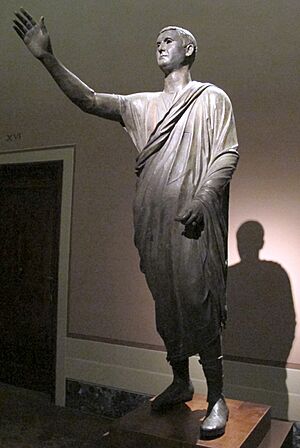
Roman society was organized in a hierarchy. At the bottom were slaves (servi). Above them were freedmen (liberti), who were former slaves. At the top were free-born citizens (cives).
Free citizens were divided into classes. The earliest division was between patricians and plebeians. Patricians could trace their family back to the city's founders. Plebeians could not. This difference became less important later in the Republic. Some plebeian families became rich and powerful.
A class system based on military service became more important. The wealthiest were the Senatorial class. They controlled politics and the army. Next were the equestrians (equites), who were a powerful merchant class. Other classes followed, based on how much military equipment they could afford. At the very bottom were the proletarii, who owned no property except their children.
Voting power in the Republic depended on class. Richer classes had more voting power. Women in ancient Rome had some basic rights but could not vote or take part in politics. However, women's rights slowly expanded. They gained property rights and more legal rights than their husbands.
Allied foreign cities were often given Latin Rights. This was a middle level between full citizens and foreigners. It gave their citizens rights under Roman law. Their main leaders could even become full Roman citizens. Most of Rome's Italian allies became full citizens after the Social War of 91–88 BC. In 212, Caracalla extended full Roman citizenship to all free-born men in the Empire.
Education in Rome
In the early Republic, there were no public schools. Boys learned to read and write from their parents or educated slaves called paedagogi. The main goal of education was to teach young men about farming, warfare, Roman traditions, and public life. Sons of nobles learned about civic life by going with their fathers to religious and political events. At 16, noble sons would work with an important political figure. At 17, they would serve in the army.
After Rome conquered Greek lands, education changed. Around age 7, if their parents could afford it, boys and some girls went to a private school called a ludus. A teacher, often Greek, taught them basic reading, writing, math, and sometimes Greek.
From age 12, students went to secondary schools. Here, a teacher called a grammaticus taught them about Greek and Roman literature. At 16, some students went to rhetoric school. This prepared them for legal careers. They had to memorize Rome's laws.
Roman Government

At first, Rome was ruled by kings. These kings were elected from Rome's main tribes. The king had great power, especially in military matters. He was also the head of the state religion. There was also the Senate, which advised the king.
The class struggles of the Roman Republic led to a mix of democracy and oligarchy (rule by a few). The word republic comes from Latin res publica, meaning "public business." Roman laws could only be passed by a vote of the people. People also voted for public leaders. However, the Roman Senate was an oligarchic group that advised the government.
In the Republic, the Senate had great influence but no real law-making power. Senators were very powerful individuals. New senators were chosen from the most successful patricians. They could be removed if found "morally corrupt."
The Republic had no fixed government offices. Taxes were collected by private groups. Government jobs were paid for by the person holding the office. To stop anyone from gaining too much power, new leaders were elected every year. They also had to share power with a colleague. For example, two consuls held the highest power. In emergencies, a temporary dictator could be appointed. The Republic's system became too slow for Rome's growing empire. This led to the creation of the Roman Empire.
In the early Empire, the idea of a republic was kept. The Roman Emperor was called a princeps, or "first citizen." The Senate gained law-making power. However, the emperors' rule became more and more autocratic (one person having all power). The Senate became just an advisory group chosen by the Emperor. The Empire did not have a fixed government system from the Republic. The Emperor appointed helpers and advisers. But the state lacked many important parts, like a central budget. Some historians say this was a big reason for the decline of the Roman Empire.
Roman Military
The early Roman army (around 500 BC) was made up of citizen soldiers. They fought like Greek hoplites. It was a small army, mainly for defense.
By the 3rd century BC, Romans changed their fighting style. They used smaller groups of 120 men called maniples. These could move more freely on the battlefield. Thirty maniples formed a legion, with 4,000 to 5,000 men. The early Republican legion had five parts: three lines of heavy infantry, light infantry, and cavalry. With this new organization, the army became more focused on attacking.
Until the late Republic, a typical soldier was a farmer who owned land. He served for specific campaigns and brought his own equipment. After 200 BC, it became harder for farmers to keep their land. So, the rules for joining the army were relaxed. From the 3rd century BC, soldiers were paid. By the time of Augustus, the army was fully professional. Augustus reorganized the military, keeping 28 legions spread across the Empire.
During the Empire, the army continued to change. New units combined cavalry and infantry. This made the army more flexible. Emperor Gallienus (253–268 AD) created a new military structure. He moved some soldiers from border bases to form mobile forces. These forces were kept behind the borders as a backup. Border troops stayed as the first line of defense.
Military leadership also changed. Under the kings, the kings led the armies. In the early and middle Republic, one of the two elected consuls commanded the military. Later, senators would serve as military leaders as part of their political careers. Under Augustus, the Emperor was the legal commander of every legion. He appointed legates (generals) from the senatorial class to lead them.
In the later Empire (starting with Diocletian), provincial governors no longer had military power. Generals were appointed by the Emperor to command armies in groups of provinces. These generals were often men who had risen through the ranks. They sometimes tried to take the Emperor's place. Fewer resources and more political chaos eventually made the Western Empire weak. This left it open to attacks and takeovers by neighboring barbarian groups.
We know less about the Roman navy than the army. Before the mid-3rd century BC, officials commanded a small fleet of 20 ships to fight piracy. This fleet was later replaced by allied forces. The First Punic War forced Rome to build large fleets. They did this mostly with help and money from allies. This reliance on allies continued until the end of the Roman Republic. The quinquereme was the main warship during the Punic Wars. It was later replaced by lighter, faster ships.
The quinquereme allowed Rome to use a mix of experienced and new crew members. This was good for a power that was mainly land-based. Its less agile design also let Romans use boarding tactics. Ships were commanded by a navarch, who was usually not a citizen. Some historians think the navy was seen as less Roman because it was mostly made up of non-Romans. So, it was allowed to weaken during peacetime.
By the late Empire (350 AD), the Roman navy had several fleets. These included warships and merchant ships for transport. Warships were galleys with three to five rows of oarsmen. Fleet bases were in ports like Ravenna, Arles, and Alexandria. Small river boat fleets were part of the border troops. They were based at fortified river harbors along the Rhine and Danube. Generals commanded both armies and fleets. This suggests that naval forces were seen as helpers to the army, not as a separate service.
Roman Economy
Ancient Rome controlled a huge area of land with many natural and human resources. So, Rome's economy focused on farming and trade. Free trade in agriculture changed Italy. By the 1st century BC, large grape and olive farms replaced small farmers. These small farmers could not compete with cheaper imported grain. When Rome took over Egypt, Sicily, and Tunisia, it got a steady supply of grains. In return, olive oil and wine were Italy's main exports.
Industrial and manufacturing activities were small. The biggest were mining and quarrying stones for buildings. Most manufacturing was done in small workshops with only a few workers. However, some brick factories employed hundreds.
The early Republic's economy was based on small farms and paid labor. But foreign wars made slaves cheap and plentiful. By the late Republic, the economy relied heavily on slave labor for both skilled and unskilled work. Slaves made up about 20% of the Roman Empire's population. In the city of Rome, it was 40%. Only when conquests stopped and slave prices rose did paid labor become more common.
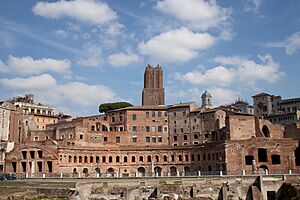
Rome had a very developed coinage system. Brass, bronze, and precious metal coins were used throughout the Empire and beyond. Some have even been found in India. Before the 3rd century BC, copper was traded by weight. The original copper coins had a face value of one Roman pound of copper, but weighed less. So, Roman money's value as exchange was always higher than its metal value.
Horses were expensive, and other pack animals were slow. Roman roads connected military posts, which became trade centers. These roads were built for wheeled vehicles. This allowed goods to be transported between Roman regions. Trade grew even more with the rise of Roman maritime trade in the 2nd century BC. Shipping by sea was about 60 times cheaper than by land. So, much larger amounts of goods could be moved by sea.
Some economists see the Roman Empire as a market economy. They compare its level of capitalism to the Netherlands in the 17th century and England in the 18th century.
Roman Culture
Roman culture spread across Western Europe and the Mediterranean Sea. Its history still has a big impact on the world today. For example, Roman ideas about laws, government, art, literature, and language are very important to European culture. The Roman language, Latin, slowly changed into modern French, Spanish, Italian, Romanian, and many other languages. Latin also influenced other languages like English.
Religion in Rome
Starting with Emperor Nero in the first century AD, the Roman government did not like Christianity. At certain times, Christians could be put to death for their beliefs. Under Emperor Diocletian, the persecution of Christians became the strongest. However, Christianity became an officially supported religion in the Roman Empire under Constantine I, who was the next Emperor. With the signing of the Edict of Milan in 313, it quickly became the biggest religion. Then in 391 AD, Emperor Theodosius I made Christianity Rome's official religion.
Roman Food
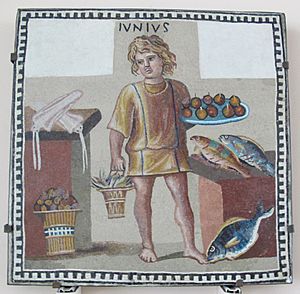
Ancient Roman food changed a lot over time. What people ate was affected by Greek culture and the huge growth of the Empire. This growth introduced Romans to many new foods and cooking styles from different provinces. At first, there wasn't much difference in food between social classes. But as the Empire grew, these differences became bigger. Both men and women drank wine with their meals.
The ancient Roman diet included many foods that are still common in modern Italian cooking. Pliny the Elder wrote about over 30 types of olives, 40 kinds of pears, and many vegetables. These included carrots (not orange ones), celery, garlic, cabbage, lettuce, onions, asparagus, and cucumber.
However, some foods that are now typical of modern Italian cooking were not used. For example, spinach and eggplant came later from the Arab world. Tomatoes, potatoes, and peppers only arrived in Europe after the discovery of the New World. The Romans knew about rice, but it was very rare for them. There were also few citrus fruits.
Meat like beef was a rare luxury. The most popular meat was pork, especially sausages. Fish was more common than meat. Romans had advanced ways of oyster farming. They also raised snails and oak grubs. Some fish were highly valued and very expensive.
Traditionally, breakfast (ientaculum) was eaten at dawn. The main meal of the day, cena, was eaten at midday or early afternoon. A light supper (vesperna) was eaten at nightfall. As more foreign foods were imported, the cena became larger and included more types of food. So, it gradually moved to the evening, and the vesperna was eventually stopped. The midday meal (prandium) became a light meal to last until cena.
Roman Fashion
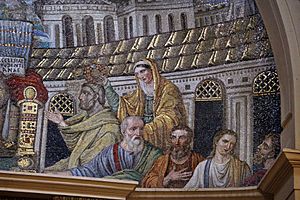
The toga, a common clothing item during Julius Caesar's time, was slowly worn less by all social classes in the Empire. By the early 4th century, the toga was only worn by senators in the Senate and for special events. It was replaced by the paenula (a poncho-like garment) as the everyday clothing for everyone.
Another popular garment in the later years of the Western Roman Empire was the pallium. This was mostly worn by philosophers and scholars. Because of influences from Germanic peoples, Romans also started wearing tunics similar to those used by Germanic tribes. They also adopted trousers and hats. In the Late Empire, the paludamentum (a type of military cloak) was only worn by the Emperor. The dalmatic (also used by Christian clergy) became popular throughout the empire.
Roman Technology
Ancient Rome had amazing technological achievements. Many of their advancements were lost during the Middle Ages and not seen again until the 19th and 20th centuries. For example, they had insulated glazing, which wasn't reinvented until the 1930s. Many practical Roman inventions came from earlier Greek designs.
Roman civil engineering and military engineering were a big part of Rome's technological strength. They built hundreds of roads, bridges, aqueducts, public baths, theaters, and arenas. Many famous buildings like the Colosseum, Pont du Gard, and Pantheon still show off Roman engineering and culture.
The Romans were famous for their architecture. It is often grouped with Greek traditions as "Classical architecture". Rome borrowed a lot from Greek building styles. However, Rome also developed new column types and the dome, which came from the Etruscan arch.
In the 1st century BC, Romans started using Roman concrete widely. Concrete was invented in the late 3rd century BC. It was a strong cement made from volcanic ash. It quickly replaced marble as the main Roman building material. This allowed for many bold architectural shapes. Also in the 1st century BC, Vitruvius wrote De architectura, which might be the first full book on architecture. Rome also began using glassblowing soon after it was invented in Syria around 50 BC.
Romans also built a lot with timber. This caused a rapid decline of forests around Rome due to the demand for wood for building, shipbuilding, and fires. Evidence shows that wood was traded over long distances. For example, wood from the Jura mountains in France was used in Rome.
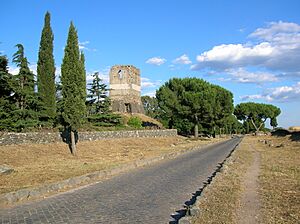
With strong foundations and good drainage, Roman roads were known for being very durable. Many parts of the Roman road system were still used a thousand years after Rome fell. Building a huge and efficient travel network across the Empire greatly increased Rome's power. It allowed Roman legions to move quickly. These roads also had a huge economic impact, making Rome a center for trade. This is where the saying "all roads lead to Rome" comes from. The Roman government had a system of rest stops and horse relays. This allowed messages to travel up to 80 km (50 mi) a day.
The Romans built many aqueducts to bring water to cities and industrial sites. They also used them for agriculture. By the 3rd century, the city of Rome was supplied by 11 aqueducts. These had a total length of 450 km (280 mi). The Romans also made big improvements in sanitation. Romans were famous for their public baths, called thermae. These were used for hygiene and social gatherings. Many Roman houses had flush toilets and indoor plumbing. A complex sewer system, the Cloaca Maxima, drained marshes and carried waste into the Tiber River.
Archaeology
Remains of Roman work and architecture have been found in the furthest corners of the late Empire.
Images for kids
-
A fresco from Pompeii showing the foundation of Rome.
-
According to legend, Rome was founded in 753 BC by Romulus and Remus, who were raised by a she-wolf.
-
Frescoes from the Villa of the Mysteries in Pompeii, Italy, Roman artwork from the mid-1st century BC.
-
A woman playing a kithara, from the Villa Boscoreale, 40–30 BC.
-
A vomitorium at the Roman amphitheatre in Trier.
See also
 In Spanish: Antigua Roma para niños
In Spanish: Antigua Roma para niños


